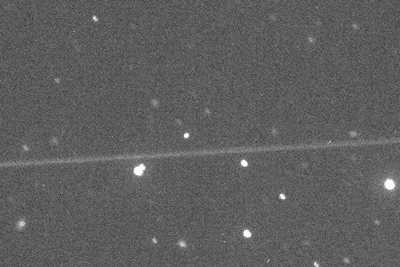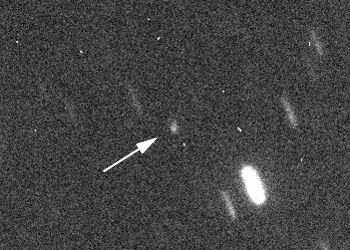
Gaia imaged by the LT on the night of 27th March 2025, some 14 hours after passivation. The image sequence runs from 22:55 - 23:43 UTC. Gaia is moving diagonally towards lower right. The near-horizontal streak in the first frame is due to a foreground geostationary satellite.
As an update to our April news item about Gaia, we can now reveal that the spacecraft started wobbling or tumbling after its deactivaion in March, as shown by LT data taken at the time.
To recap, Gaia finished its science mission in January of this year, and was deactivated on the morning of 27th March. This involved commanding Gaia to boost out of its Lissajous orbit around the Sun-Earth L2 Lagrange point, 1.5 million km from Earth, vent any remaining propellant, and finally shut itself down.
Later that same day the LT observed Gaia again (see right), but the image sequence showed it to be flickering between magnitude +17 & +22, rather than having a steady brightness as before.
Previously, Gaia's sunshield was kept at a fixed angle to the Sun and Earth. This new fluctuation suggested Gaia might be undergoing large-amplitude precession and/or nutation, or even tumbling end-over-end.
Dr Martin Altmann, director of the Gaia Ground Based Optical Tracking (GBOT) campaign, analysed this data plus that from further intermittent observations (mostly by LT) over the following weeks. The full analysis can be seen in an "Image of the Week" article in the Gaia section of the "Cosmos" Science Users' Portal of the European Space Agency (ESA) website.
In the article, the rotation period is initially deduced to be approximately 20 minutes. However, Altmann is quick to point out that there might be up to four reflective surfaces involved - both sides of the sunshield and the spacecraft's cylindrical hull. The period might for example be more like 40 minutes, involving two reflections from both sides of the sunshield. This, plus an evolving Sun-Gaia-Earth phase angle, yields an overall complex reflection signature which makes it difficult to conclude a rotational period from this data.
Martin Altmann's full article can be found on tne ESA website at https://www.cosmos.esa.int/web/gaia/iow_20250929.

The LT's last image of Gaia (arrowed) in a long exposure on 29th May 2025. The telescope tracked on Gaia's expected trajectory, so the streaks are stars in the background. The small dots are cosmic ray hits on the CCD. North is at top, and the field is about 100 arcseconds wide.
The LT's last detection of Gaia (see right) was on the early morning of 29th May, when the peak brightness had diminished to magnitude +20.7. Gaia was still only about twice as far as it had been during its standard science mission (3.15 million km), so this drop in brightness seemed unusual at first. However, it was likely due more to the evolving Sun-Gaia-Earth phase angle rather than distance. Earth was now probably moving out of the main part of Gaia's relatively narrow (compared to diffuse reflection) specular beam of reflected sunlight.
Gaia is now (13 Oct) over 28 million km away, drifting further and further behind the Earth in its larger heliocentric orbit. In 14 years it should fly by Earth again (as we "lap" Gaia around the Sun), at a safe distance of about 10 million km. If Gaia is still tumbling by then, its peak magnitude as estimated by Altmann will be 23-23.5.
As stated previously, Gaia's duty is finished, but work continues to analyse and publish its data. The enormous catalogues of Data Releases 1-3 actually only make up under a third of the total information to be released. Data Release 4 is due at the end of 2026, and Release 5 after 2030.


